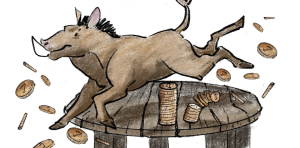In part 1 I discussed some things I do and don’t like about character progression in games.
In part 2 I wrote a criteria to examine character progression with: Is it appreciable, qualitative and distinctive?
Character progression often comes out of the blue.
You suddenly know countercharm because you are a 6th level bard.
We generally just handwave this away as the character having gained experience, but the experience generally doesn’t match the new progression.
Below are three ways of improving on this.
Critical Role’s system
In lower-level episodes of Critical Role, when the players level up and are in a city, they often spend part of the next session playing out downtime vignettes showing how they obtained their new features and abilities.
For instance, the wizard and the arcane trickster might play out a scene where the wizard teaches the trickster how to cast their new spell.
Or the Monk goes to a monastery in the city, spars with her superiors and can now do a punch which stuns opponents.
I like how the progression is represented in world, it’s preferable to suddenly getting new features, because the events in the fiction are matching the changes in the mechanics.
But its a bit cart before horse.
The mechanical changes have primacy, and the fiction is played out to explain them.

The Montage System
One of the first games I ever played in was an excellent homebrew mess set in Ravnica. When we leveled up we told the GM what sort of new feature we wanted the character to get. There would then be some collaborative discussion to make sure the feature was not too over/under-powered. Then we played out as a montage a series of short narrations representing how we had gained that feature.
The GM gave us prompts and we would improv off of them.
For instance, if I wanted my character to get a new poison attack we might spend a couple of minutes describing:
- Chasing a lizard around the laboratory with a giant net
- Swirling a purple chemical in a flask as I pour some green goo into it
- Using a pipette to drop the poison onto a slab of meat, which sizzles and deteriorates at its touch
and at the end I have a new ability.
You can also put a short 2 minute song on in the background to act as a timer, it will make things more frantic.
This is better than the critical role system because it is quicker, more fun, and the progression is player directed. I don’t get a new feature because “the rules say that when I get to 6th level I now know countercharm”. Rather I get a new feature because that is what the GM and I both agree fits the character at this point in time.
I think we can still do better though.
The progression here is not flagged in advance. It doesn’t necessarily flow logically from the recent actions of the character.

The Flag System
Put a piece of paper in the middle of the table with all the player character names on it. Write Development Goals at the top.
Each player writes by their character’s name the next bit of development they want for their character. Like this:
Development Goals
- Dillon, Sorcerer Supreme: Magic which will allow me to infiltrate the halls of the Archmage Candlestick
- Jango the fighter: A magic axe
- Thrasos the Biomancer: A way to hear better that will synergise with the screeching ability I already have to allow echolocation
- Jessop: An audience with the Mayor
- Sally: Access to the restricted section of the town library
By writing down development goals you are flagging for the other players, and for the GM, content that you want to appear in the game.
As a GM, this is useful because it makes prep easier – just look at the Development Goals and see if there is a way to work them in.
It also makes improv easier for the GM – have the development goals on your GM screen and use it for inspiration.
It also gives the party five self-made quests/goals.
When you complete the goal, you get the progression.
You can be very precise or a little vague. The more vague, the quicker you might complete the goal but the less precise the result. You get a magic axe, but you don’t get that particular one with that particular ability.
The fiction has primacy, and the rules and mechanics follow them. The horse is before the cart.
Design notes
This system could be used on top of a comprehensive rule system like 5e. That wouldn’t stop the features you get from character advancement in the rules just appearing. However, it would still be useful for other progression. You could use it in tandem with the montage system.
This could also be used wholesale as a character progression system in a rules light game.
I’ve used the word development here instead of the word progression. There was a post by Dreaming Dragonslayer about development, wherein the terms development vs advancement were discussed. I think development fits the flag system better than the progression I was using before. Progression gives me an image of a continuous march towards an overriding goal. This is more haphazard than that. I’ve been thinking about this flag system for a while but reading that post gave me the push to write it up.
